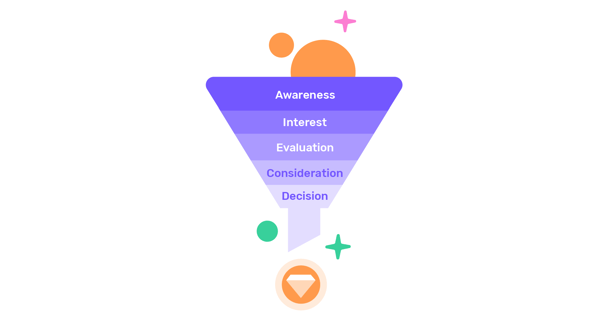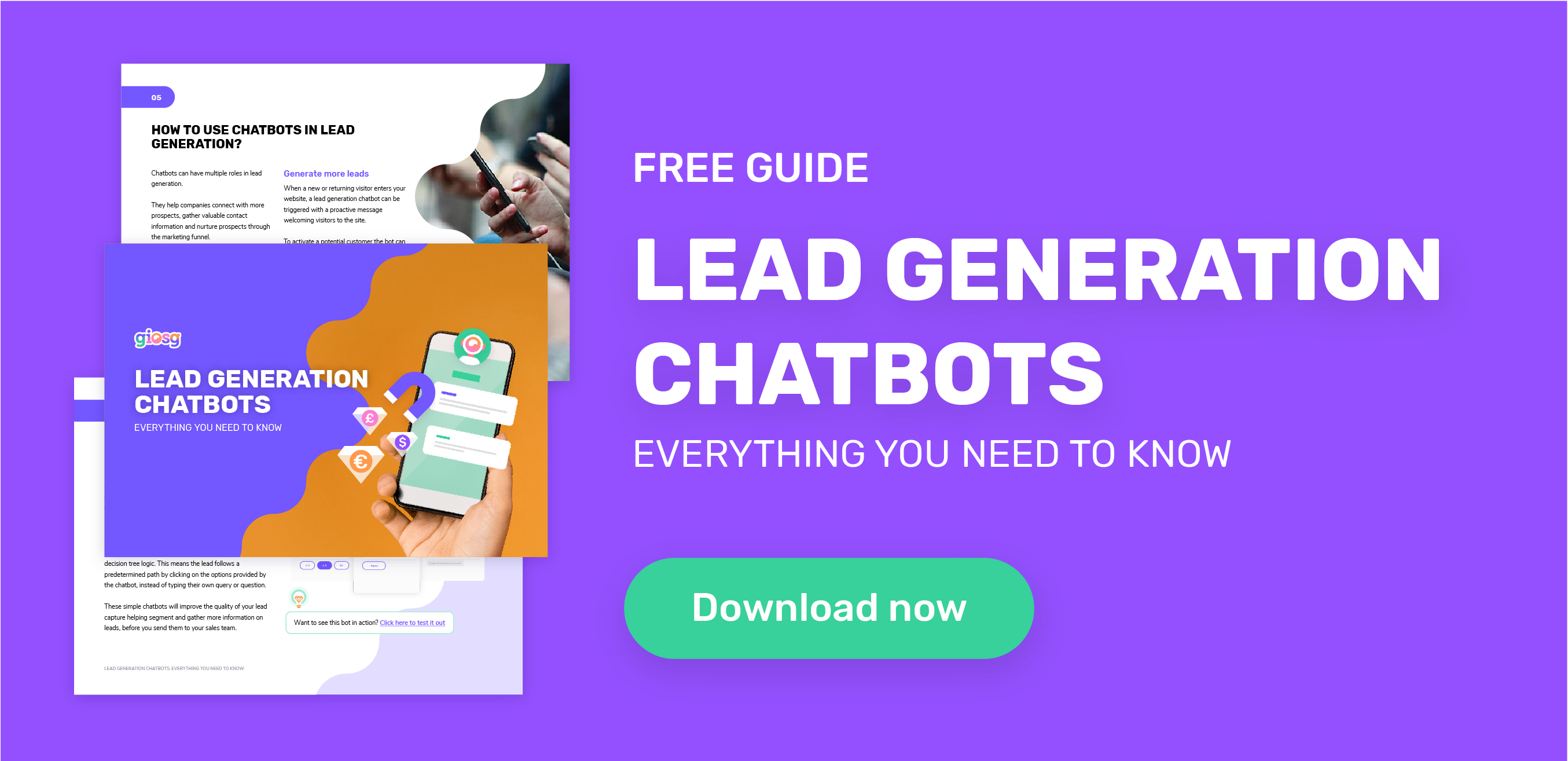Conversational marketing is a customer-centric and dialogue-driven approach to marketing.
It has become the go-to strategy for driving customer engagement, improving customer experience, and growing revenue.
The name itself tells a lot about the term already - but if you're wondering how conversational marketing works, why it's so important, and where it fits in with the world of inbound, keep on reading!

Conversational marketing in a nutshell
Conversational marketing is based on one-to-one interactions in real-time across multiple channels. It enables you to foster customer relationships and improve your online customer experience by communicating and customizing interactions online.
Live chat, chatbots, and messaging apps are used to enable these personalized conversations.
Chatbots in particular have made conversational marketing more accessible. The two solutions are regularly grouped as the same thing, but chatbots are just a part of conversational marketing - like a goalkeeper of a football team, you wouldn’t argue that they make up the entire team.
Any form of two-way communication, like phone and email, can be part of a conversational marketing strategy. Although today, messaging is the most popular way to get in touch and reach out to customers. People love to chat and want instant responses, which is part of the reason why messaging apps like WhatsApp are so popular.
The key in conversational marketing is assessing and understanding what your customers’ preferred channels are and adjusting your tone of voice accordingly - dialogue with chatbots and live chat is usually quite informal and mimics a casual conversation.
Conversational marketing VS. Inbound marketing
So is there a difference between inbound and conversational marketing?
Yes and no. Conversational marketing is often considered a part of an inbound marketing strategy.
Inbound is the "pull" tactic of attracting customers through the channels they prefer. Conversational marketing, on the other hand, is the method of actually conversing with customers in these channels.
It is the way you interact with your customers by providing them with the power of when, how, and where they communicate with your business. Both are by nature customer-centric and go hand-in-hand.
Chatbots in conversational marketing
As mentioned, when talking about conversational marketing people automatically think of chatbots.
Rightly so, as they do play a big role in the implementation of conversational marketing as a communication channel. This is because chatbots use a conversational approach and simulate face-to-face interactions.
Today, chatbots come in all shapes and sizes with various capabilities and levels of advancement, from chatbots with AI capabilities to less advanced bots like button-based bots.
In conversational marketing, chatbots are often used to automate the process of gathering data, providing information about products/services, and qualifying your leads further.
The fact that chatbots are more and more common on websites and social media platforms is bound to raise customer expectations, and therefore, bots need to show that they’re efficient in communicating and providing the value customers are looking for.
Benefits of conversational marketing
When you’re doing it right, conversational marketing provides multiple benefits that can give you an advantage over the competition in your market.
1. Better customer experience
First, having conversations with your website visitors helps you learn more about their needs and pain points, and collect the information you need to qualify them further.
Based on what they’re interested in and where they’re in their buyer process, you’ll be able to adjust your communication, send them relevant, targeted messages and interact with them in a meaningful way.
These meaningful conversations can be run 24/7 to help you build trust in your company throughout the purchasing journey, and further develop relationships with your customers.
2. Improved lead generation
By providing an interactive way for customers and prospects to engage with your company, you’re able to optimise customer experiences and convert more visitors into paying customers.
Conversations not only help you convert leads but also qualify them for your sales when you’re asking the right questions at the right time.
3. Move buyers through your sales funnel faster
When your marketing activities are connected with your sales team, you can be sure you’re moving your buyers through your marketing and sales funnels in an effective way.
Bots can send qualified leads directly to your sales agents on live chat, as well as book meetings with sales in real time.

Conversational marketing strategy
Choosing the best conversational marketing strategy should be based on your company's business goals. These objectives define what you’re ultimately trying to achieve with your conversational marketing.
It’s good to start by evaluating what kind of conversations you would like to have with your audience and what are problems you’re trying to solve with these strategies.
1. Choose your channels and define Q&As
Knowing your audience and their needs helps in determining what kind of channels you need and for what purpose, whether it’s to answer generic FAQs, provide information related to your products or services, assist in finalizing a purchase, or promote your gated content or demos.
Deciding on what kind of questions and answers your bot covers should be based on the information your sales team needs to qualify a lead.
The nature of questions depends on your objectives and should be adjusted to the different stages of the customer journey.
2. Personalize and optimize
Personalizing your conversations based on your customers’ behaviour and the stage of their customer journey enables you to show them the right content in the right channels at the right time.
Whether this means sharing a PDF of the user manual with an existing customer or simply helping a new visitor sign up for a plan, effectively automating customer communication is key.
People appreciate when they see relevant and timely information and have authentic interactions. As a result, you're able to strengthen the customer relationship.
To get the most out of your strategy, you have to continuously optimize your marketing conversations. After launching a chatbot, it’s all about testing. You need to analyse the data of the conversations, your customer’s journey, and the level of engagement – and alter conversation flows based on the findings.
Then, get it going again and repeat the steps.
3. Ask for feedback
Collecting feedback from your customers and prospects plays an important role in developing your conversational strategy further.
It can reveal the weaknesses and areas of improvement, and help you create more meaningful interactions, and thus further enhance customer experience.
How to use conversational marketing?
We've gained useful insight into how to best use conversational marketing and best practices of how to get started.
Here are just a few of our tips to help you, if you're looking to start conversations with your website visitors:
First, decide where you want your conversations to take place.
Implementing your conversational marketing strategy starts by choosing the pages where you want your conversational bot to engage with your visitors.
To maximize the number of interactions and your results, choose the pages that get both the most traffic and have visitors with a high intention of buying.
Then, plan your conversation flow.
Then once you know where you want to have your bot placed, you can move to plan the bot conversation flow.
Based on your conversational marketing strategy and the stages of the customer journey of the page visitors, define what kind of information you need to ask and how many questions are required.
For a good customer experience, try to keep the conversations simple in all of your different conversation flows. People expect the interaction with your company to be smooth and want to get answers and guidance quickly.
Check out these conversational marketing examples to get a better idea of how this can help your business!
Ready to add conversational marketing to your plans?
We hope we’ve convinced you with the above-mentioned benefits and conversational marketing examples that it's time to level up your 2023 marketing strategy.
Conversational marketing can help you and your customers throughout the entire online customer journey - from a visitor interested in educating themselves, to a prospect looking for information on your products and an existing customer needing support with a new purchase.
Start getting the ready-to-buy qualified leads that you’re looking for, shorten the sales cycles and move your online leads through the buyer’s journey faster. Build trust and develop your customer relationships further with these meaningful interactions.
Want to learn more about optimising your lead generation with a conversational approach? Read our lead generation chatbot guide.
